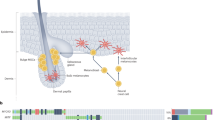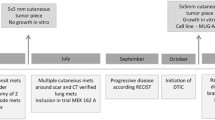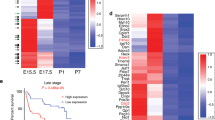Abstract
The Grey horse phenotype, caused by a 4.6 kb duplication in Syntaxin 17, is strongly associated with high incidence of melanoma. In contrast to most human melanomas with an early onset of metastasis, the Grey horse melanomas have an extended period of benign growth, after which 50% or more eventually undergo progression and may metastasize. In efforts to define changes occurring during Grey horse melanoma progression, we established an in vitro model comprised of two cell lines, HoMel-L1 and HoMel-A1, representing a primary and a metastatic stage of the melanoma, respectively. The cell lines were examined for their growth and morphological characteristics, in vitro and in vivo oncogenic potential, chromosome numbers, and expression of melanocytic antigens and tumor suppressors. Both cell lines exhibited malignant characteristics; however, the metastatic HoMel-A1 showed a more aggressive phenotype characterized by higher proliferation rates, invasiveness, and a stronger tumorigenic potential both in vitro and in vivo. HoMel-A1 displayed a near-haploid karyotype, whereas HoMel-L1 was near-diploid. The cell lines expressed melanocytic lineage markers such as TYR, TRP1, MITF, PMEL, ASIP, MC1R, POMC, and KIT. The tumor suppressor p53 was strongly expressed in both cell lines, while the tumor suppressors p16 and PTEN were absent in HoMel-A1, potentially implicating significance of these pathways in the melanoma progression. This in vitro model system will not only aid in understanding of the Grey horse melanoma pathogenesis, but also in unraveling the steps during melanoma progression in general as well as being an invaluable tool for development of new therapeutic strategies.




Similar content being viewed by others
References
Atkin N. B.; Baker M. C. A metastatic malignant melanoma with 24 chromosomes. Hum Genet 58: 217–219; 1981.
Bar-Eli M. Role of AP-2 in tumor growth and metastasis of human melanoma. Cancer Metastasis Rev 18: 377–385; 1999.
Bennett D. C. Human melanocyte senescence and melanoma susceptibility genes. Oncogene 22: 3063–3069; 2003.
Castresana J. S.; Rubio M. P.; Vazquez J. J.; Idoate M.; Sober A. J.; Seizinger B. R.; Barnhill R. L. Lack of allelic deletion and point mutation as mechanisms of p53 activation in human malignant melanoma. Int J Cancer 55: 562–565; 1993.
Cengelli F.; Grzyb J. A.; Montoro A.; Hofmann H.; Hanessian S.; Juillerat-Jeanneret L. Surface-functionalized ultrasmall superparamagnetic nanoparticles as magnetic delivery vectors for camptothecin. ChemMedChem 4: 988–997; 2009.
Chapman S. W. K.; Metzger N.; Grest P.; Feige K.; von Rechenberg B.; Auer J. A.; Hottiger M. O. Isolation, establishment, and characterization of ex vivo equine melanoma cell cultures. In Vitro Cell Dev Biol Anim 45: 152–162; 2009.
Dovc P.; Susnik S.; Snoj A. Experience from Lipizzan horse and salmonid species endemic to the Adriatic river system. Examples for the application of molecular markers for preservation of biodiversity and management of animal genetic resources. J Biotechnol 113: 43–53; 2004.
Fleury C.; Berard F.; Balme B.; Thomas L. The study of cutaneous melanomas in Camargue-type gray-skinned horses (1): clinical-pathological characterization. Pigment Cell Res 13: 39–46; 2000.
Goel V. K.; Ibrahim N.; Jiang G.; Singhal M.; Fee S.; Flotte T.; Westmoreland S.; Haluska F. S.; Hinds P. W.; Haluska F. G. Melanocytic nevus-like hyperplasia and melanoma in transgenic BRAFV600E mice. Oncogene 28: 2289–2298; 2009.
Gorham S, Robl M (1986) Melanoma in the Gray Horse - the Darker Side of Equine Aging. Veterinary Medicine 81: 446-&.
Guerriere-Kovach P. M.; Hunt E. L.; Patterson J. W.; Glembocki D. J.; English 3rd J. C.; Wick M. R. Primary melanoma of the skin and cutaneous melanomatous metastases: comparative histologic features and immunophenotypes. Am J Clin Pathol 122: 70–77; 2004.
Hearing JV, Leong SPL (2006) From Melanocytes to Melanoma: The Progression to Malignancy Humana Press Totowa, New Jersey.
Herlyn D.; Iliopoulos D.; Jensen P. J.; Parmiter A.; Baird J.; Hotta H.; Adachi K.; Ross A. H.; Jambrosic J.; Koprowski H.; Herlyn M. In vitro properties of human melanoma cells metastatic in nude mice. Cancer Res 50: 2296–2302; 1990.
Kannan K.; Sharpless N. E.; Xu J.; O'Hagan R. C.; Bosenberg M.; Chin L. Components of the Rb pathway are critical targets of UV mutagenesis in a murine melanoma model. Proc Natl Acad Sci USA 100: 1221–1225; 2003.
Koenig A.; Wojcieszyn J.; Weeks B. R.; Modiano J. F. Expression of S100a, vimentin, NSE, and melan A/MART-1 in seven canine melanoma cells lines and twenty-nine retrospective cases of canine melanoma. Vet Pathol 38: 427–435; 2001.
Luis C.; Juras R.; Oom M. M.; Cothran E. G. Genetic diversity and relationships of Portuguese and other horse breeds based on protein and microsatellite loci variation. Anim Genet 38: 20–27; 2007.
MacGillivray K. C.; Sweeney R. W.; Del Piero F. Metastatic melanoma in horses. J Vet Intern Med 16: 452–456; 2002.
Monahan K. B.; Rozenberg G. I.; Krishnamurthy J.; Johnson S. M.; Liu W.; Bradford M. K.; Horner J.; Depinho R. A.; Sharpless N. E. Somatic p16(INK4a) loss accelerates melanomagenesis. Oncogene 29: 5809–5817; 2010.
Patton E. E.; Widlund H. R.; Kutok J. L.; Kopani K. R.; Amatruda J. F.; Murphey R. D.; Berghmans S.; Mayhall E. A.; Traver D.; Fletcher C. D.; Aster J. C.; Granter S. R.; Look A. T.; Lee C.; Fisher D. E.; Zon L. I. BRAF mutations are sufficient to promote nevi formation and cooperate with p53 in the genesis of melanoma. Curr Biol 15: 249–254; 2005.
Ragnarsson-Olding B. K.; Karsberg S.; Platz A.; Ringborg U. K. Mutations in the TP53 gene in human malignant melanomas derived from sun-exposed skin and unexposed mucosal membranes. Melanoma Res 12: 453–463; 2002.
Raposo G.; Tenza D.; Murphy D. M.; Berson J. F.; Marks M. S. Distinct protein sorting and localization to premelanosomes, melanosomes, and lysosomes in pigmented melanocytic cells. J Cell Biol 152: 809–824; 2001.
Rosengren Pielberg G.; Golovko A.; Sundström E.; Curik I.; Lennartsson J.; Seltenhammer M. H.; Druml T.; Binns M.; Fitzsimmons C.; Lindgren G.; Sandberg K.; Baumung R.; Vetterlein M.; Stromberg S.; Grabherr M.; Wade C.; Lindblad-Toh K.; Ponten F.; Heldin C. H.; Solkner J.; Andersson L. A cis-acting regulatory mutation causes premature hair graying and susceptibility to melanoma in the horse. Nat Genet 40: 1004–1009; 2008.
Seltenhammer M. H.; Heere-Ress E.; Brandt S.; Druml T.; Jansen B.; Pehamberger H.; Niebauer G. W. Comparative histopathology of Grey horse melanoma and human malignant melanoma. Pigment Cell Res 17: 674–681; 2004.
SAS Institute Inc. Base SAS(R)9.2 Procedures Guide. Cary, NC: SAS Institute Inc. 2011.
Sharpless N. E.; Kannan K.; Xu J.; Bosenberg M. W.; Chin L. Both products of the mouse Ink4a/Arf locus suppress melanoma formation in vivo. Oncogene 22: 5055–5059; 2003.
Sundström E.; Imsland F.; Mikko S.; Wade C.; Sigurdsson S.; Pielberg G. R.; Golovko A.; Curik I.; Seltenhammer M. H.; Solkner J.; Lindblad-Toh K.; Andersson L. Copy number expansion of the STX17 duplication in melanoma tissue from Grey horses. BMC Genomics 13: 365; 2012.
Sundström E.; Komisarczuk A. Z.; Jiang L.; Golovko A.; Navratilova P.; Rinkwitz S.; Becker T. S.; Andersson L. Identification of a melanocyte-specific, microphthalmia-associated transcription factor-dependent regulatory element in the intronic duplication causing hair graying and melanoma in horses. Pigment Cell Melanoma Res 25: 28–36; 2011.
Sutton R. H.; Coleman G. T. Melanoma and the Graying horse. RIRDC Research, Paper Series Barton, Australia; 1997.
Tlsty T. D.; Briot A.; Gualberto A.; Hall I.; Hess S.; Hixon M.; Kuppuswamy D.; Romanov S.; Sage M.; White A. Genomic instability and cancer. Mutat Res 337: 1–7; 1995.
Toti P.; Greco G.; Mangiavacchi P.; Bruni A.; Palmeri M. L.; Luzi P. DNA ploidy pattern in choroidal melanoma: correlation with survival. A flow cytometry study on archival material. Br J Ophthalmol 82: 1433–1437; 1998.
Valentine B. A. Equine melanocytic tumors: a retrospective study of 53 horses (1988 to 1991). J Vet Intern Med 9: 291–297; 1995.
Yajima I.; Kumasaka M. Y.; Thang N. D.; Goto Y.; Takeda K.; Yamanoshita O.; Iida M.; Ohgami N.; Tamura H.; Kawamoto Y.; Kato M. RAS/RAF/MEK/ERK and PI3K/PTEN/AKT signaling in malignant melanoma progression and therapy. Dermatol Res Pract 2012: 354191; 2012.
Yu H.; McDaid R.; Lee J.; Possik P.; Li L.; Kumar S. M.; Elder D. E.; Van Belle P.; Gimotty P.; Guerra M.; Hammond R.; Nathanson K. L.; Dalla Palma M.; Herlyn M.; Xu X. The role of BRAF mutation and p53 inactivation during transformation of a subpopulation of primary human melanocytes. Am J Pathol 174: 2367–2377; 2009.
Acknowledgment
The anti-PMEL antibodies were kindly provided by Dr. Michael S. Marks (University of Pennsylvania, Philadelphia, PA). The study was supported by the Swedish Cancer Society (project number CAN 2011/703) and Swedish-Norwegian Foundation for Equine Research (project number H1047299).
Author information
Authors and Affiliations
Corresponding author
Additional information
Editor: T. Okamoto
Rights and permissions
About this article
Cite this article
Seltenhammer, M.H., Sundström, E., Meisslitzer-Ruppitsch, C. et al. Establishment and characterization of a primary and a metastatic melanoma cell line from Grey horses. In Vitro Cell.Dev.Biol.-Animal 50, 56–65 (2014). https://doi.org/10.1007/s11626-013-9678-1
Received:
Accepted:
Published:
Issue Date:
DOI: https://doi.org/10.1007/s11626-013-9678-1




